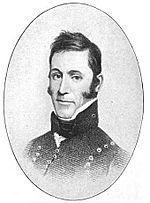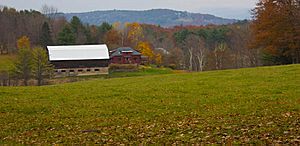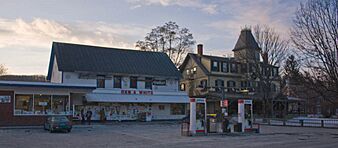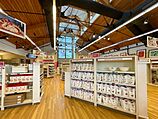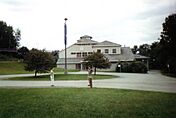Norwich, Vermont facts for kids
Quick facts for kids
Norwich, Vermont
|
|
|---|---|
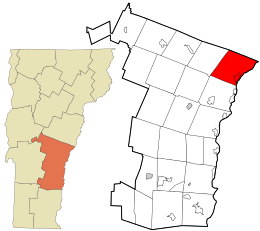
Location in Windsor County and the state of Vermont.
|
|
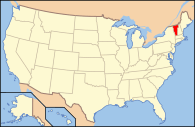
Location of Vermont within the US
|
|
| Country | United States |
| State | Vermont |
| County | Windsor |
| Chartered | 1761 |
| Communities |
|
| Area | |
| • Total | 44.7 sq mi (115.7 km2) |
| • Land | 44.4 sq mi (115.1 km2) |
| • Water | 0.2 sq mi (0.6 km2) |
| Elevation | 531 ft (274 m) |
| Population
(2020)
|
|
| • Total | 3,612 |
| • Density | 80.86/sq mi (31.219/km2) |
| Time zone | UTC−5 (EST) |
| • Summer (DST) | UTC−4 (EDT) |
| ZIP Codes |
05055 (Norwich)
05001 (White River Junction) |
| Area code(s) | 802 |
| FIPS code | 50-52900 |
| GNIS feature ID | 1462166 |
Norwich is a town located in Windsor County, Vermont, in the United States. In 2020, about 3,612 people lived there. Norwich is known as a place where many people live who work in nearby Hanover, New Hampshire. These two towns are connected by the Connecticut River.
Norwich is also part of the Dresden School District. This was the very first school district in the United States that included schools from different states. President John F. Kennedy made this possible. The town also has a special area called the Norwich Mid-Century Modern Historic District. This district is known for its unique buildings from the middle of the 20th century.
Contents
History of Norwich
The area that is now Norwich was officially created on July 4, 1761. This happened when Governor Benning Wentworth set the borders for towns in Vermont. The first people to settle here arrived in 1763. They started clearing the land and building log homes. They spent their first winter in 1765.
Early settlements were mostly along the Ompompanoosuc River. Later, people began to settle in the area where the main village is today. The town held its first official meeting in April 1768. The first church, a Congregational church, was started in 1770. Its building was finished in 1778. The number of people living in Norwich grew a lot. It went from 206 in 1771 to 2,316 by 1830.
The town was named after Norwich, Connecticut. This is where many of the first settlers came from. In the original document that created the town, the name was spelled "Norwhich." However, the extra 'h' was removed soon after. The name used to be said like "Norritch," similar to how people say the city of Norwich, England. But now, most people say "Nor-wich."
Alden Partridge and Norwich University
In 1819, a man named Alden Partridge founded a school in Norwich. He was born in Norwich and used to be in charge of the United States Military Academy at West Point, New York. He wanted to create a new way to train students, called "cadets." His school, the "American Literary, Scientific and Military Academy," taught both arts and sciences, along with military skills.
During his six years in Norwich, Partridge's school grew to almost 500 students. In 1825, he moved the school to Middletown, Connecticut. But he came back to Norwich in 1835. He started another military academy with permission from the U.S. Congress. This school stayed in Norwich until 1866, when it burned down. After the fire, the school moved to Northfield, Vermont. Today, it is known as Norwich University.
Geography of Norwich
Norwich is located on the western side of the Connecticut River. This river forms the border between Vermont and New Hampshire. Across the river from Norwich is the town of Hanover, New Hampshire. The Ledyard Bridge connects these two towns.
Other towns next to Norwich in Vermont are Thetford to the north, Sharon to the west, and Hartford to the south.
According to the United States Census Bureau, Norwich covers a total area of about 115.7 square kilometers (44.7 square miles). Most of this area, about 115.1 square kilometers (44.4 square miles), is land. Only a small part, about 0.6 square kilometers (0.2 square miles), is water. The Ompompanoosuc River flows into the Connecticut River in the northern part of the town.
The land in Norwich is mostly hilly and covered with trees. The center of Norwich town is about 274 meters (531 feet) above sea level. Some of the hills in town include Griggs Mountain, which is about 518 meters (1,700 feet) tall, and Gile Mountain, which is about 565 meters (1,853 feet) tall.
Norwich Population and People
| Historical population | |||
|---|---|---|---|
| Census | Pop. | %± | |
| 1790 | 1,158 | — | |
| 1800 | 1,486 | 28.3% | |
| 1810 | 1,812 | 21.9% | |
| 1820 | 1,985 | 9.5% | |
| 1830 | 2,316 | 16.7% | |
| 1840 | 2,218 | −4.2% | |
| 1850 | 1,978 | −10.8% | |
| 1860 | 1,759 | −11.1% | |
| 1870 | 1,639 | −6.8% | |
| 1880 | 1,471 | −10.3% | |
| 1890 | 1,304 | −11.4% | |
| 1900 | 1,303 | −0.1% | |
| 1910 | 1,252 | −3.9% | |
| 1920 | 1,092 | −12.8% | |
| 1930 | 1,371 | 25.5% | |
| 1940 | 1,418 | 3.4% | |
| 1950 | 1,532 | 8.0% | |
| 1960 | 1,790 | 16.8% | |
| 1970 | 1,966 | 9.8% | |
| 1980 | 2,398 | 22.0% | |
| 1990 | 3,093 | 29.0% | |
| 2000 | 3,544 | 14.6% | |
| 2010 | 3,414 | −3.7% | |
| 2020 | 3,612 | 5.8% | |
| U.S. Decennial Census | |||
In 2000, there were 3,544 people living in Norwich. These people lived in 1,367 households, and 944 of these were families. The town had about 79 people per square mile.
About 96% of the people in Norwich were White. Other groups included African American, Native American, and Asian people. Less than 1% of the population was Hispanic or Latino.
Many households, about 41%, had children under 18 living with them. The average household had about 2.59 people. The average family had about 3.10 people.
The population of Norwich included people of all ages. About 29% were under 18, and 11% were 65 or older. The average age in town was 41 years old.
In 2000, the average income for a household in Norwich was $66,000 per year. For families, the average income was $78,178. A small number of families, about 1.5%, lived below the poverty line.
Commerce and Culture
The main part of Norwich has a traditional general store that is still very popular. Next to the general store is an old inn that has been fixed up. It has a restaurant and a place that makes its own drinks.
Two well-known places in Norwich are the Montshire Museum of Science and the King Arthur Baking Company. The Montshire Museum is a fun place to learn about science. King Arthur Baking is famous for its baking ingredients and recipes.
Education in Norwich
Norwich has a special public school system called the Dresden School District. This is one of the few school systems in the country that serves students from two different states. It is shared by the towns of Norwich, Vermont, and Hanover, New Hampshire.
Younger students in Norwich go to Marion Cross School for kindergarten through sixth grade. For grades seven and eight, students attend Richmond Middle School in Hanover. Older students, from ninth through twelfth grade, go to Hanover High School in Hanover.
Transportation in Norwich
Several important transportation routes pass through Norwich, following the Connecticut River valley. These include Interstate 91, which has an exit (Exit 13) that serves the town. Also, U.S. Route 5 runs through Norwich. There's also an old railroad path that is now owned by the State of Vermont.
The Appalachian Trail, a very long hiking path, also goes through Norwich. It enters the town from Hartford to the south and then continues east towards Hanover, New Hampshire.
Notable People from Norwich
- Elizabeth Emerson Atwater, a botanist from the 1800s
- William Barron, a U.S. Marshal
- Charles L. Bartlett, who was a mayor in Massachusetts
- Paul Brigham, the second governor of Vermont
- Heinrich Brüning, a former leader of Germany
- Daniel Azro Ashley Buck, a U.S. congressman
- Nicholas A. Christakis, a sociologist, professor, and doctor
- Zerah Colburn, a child who was amazing at math in his head
- George A. Converse, a navy admiral
- Pamela Kyle Crossley, a historian
- Jonathan Finer, a government advisor
- Joseph D. Hatch, a Vermont politician and mayor
- Jim Holland, an Olympic ski jumper
- Joe Holland, an Olympic Nordic combined skier
- Mike Holland, an Olympic ski jumper
- Norris Hoyt, a politician and lawyer
- Hannah Kearney, an Olympic medalist in mogul skiing
- Bob Keeshan, known as "Captain Kangaroo" on TV
- Laurence G. Leavitt, a school headmaster
- Tony Lupien, a baseball player for teams like the Red Sox
- David Macaulay, a famous author and illustrator
- Felix McGrath, an Olympic alpine skier
- Freya von Moltke, an author who wrote about German resistance to Nazism
- Robby Mook, a presidential campaign manager
- George Sylvester Morris, an educator and writer
- Alden Partridge, who founded Norwich University
- Lewis Samuel Partridge, Alden Partridge's nephew and a U.S. Marshal
- Kevin Pearce, a snowboarder
- Simon Pearce, a glassblower and designer
- Thomas E. G. Ransom, a general in the American Civil War
- Eugen Rosenstock-Huessy, a historian and philosopher
- Paul Sample, an artist
- Walter H. Stockmayer, a chemist and professor
- Andrew Wheating, an Olympic runner
- Edward Bancroft Williston, a Medal of Honor winner
- George Wright, a general in the American Civil War
See also
 In Spanish: Norwich (Vermont) para niños
In Spanish: Norwich (Vermont) para niños


